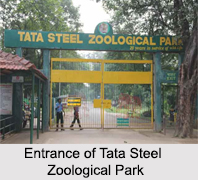 Tourism in Jamshedpur in East Singbhum District of Jharkhand touches the urban life with the well planned architecture of modern era with industrial importance. Jamshedpur portrays the architectural excellences in city planning with a good proportion of man and nature.
Tourism in Jamshedpur in East Singbhum District of Jharkhand touches the urban life with the well planned architecture of modern era with industrial importance. Jamshedpur portrays the architectural excellences in city planning with a good proportion of man and nature.
Some of the tourist attractions of Jamshedpur are Kharkai Bridge (near Kharkai River), Bhubaneshwari Temple, Jubilee Park, Tata Steel Zoological Society, Dalma Hills, Hudco Lake, Pardih Kali Mandir and many other tourist attraction sites.
 Jamshedpur is called the `Steel City`. Since it was founded by the late Jamshedji Nusserwanji Tata, it is also called Tata Nagar. Jamshedpur is a planned industrial city, surrounded by the Dalma Hills and the rivers like Subarnarekha River and Kharkai River.
Jamshedpur is called the `Steel City`. Since it was founded by the late Jamshedji Nusserwanji Tata, it is also called Tata Nagar. Jamshedpur is a planned industrial city, surrounded by the Dalma Hills and the rivers like Subarnarekha River and Kharkai River.
Dimna Lake
Dimna Lake is only 13km from Jamshedpur. Dimna Lake is bounded by variety of flora, and can be reached after a drive.
Hudco Lake
Hudco Lake is an artificial lake of the TELCO Colony. It is bordered with beautiful natural scenery. It is situated near an eco park maintained by Tatas which also houses an artificial waterfall that uses the water of the lake.
Jubilee Park
Jubilee Park is spread over 237.75 acres of land. The park was inaugurated in the year 1956. The green landscape, an amusement park, skating rink and a horticulture garden are the attractions. It contains a wide variety of plant species.
Domohani
Domohani is the meeting place of Subarnekha River and Kharkai River. It serves as a picnic spot inside Jamshedpur. Domohani is bordered with eucalyptus trees and luxuriant natural vegetation.
Dalma Wildlife Sanctuary
Dalma Wildlife Sanctuary is situated at an altitude of 3000 ft. It is spread over an area of 193 sq km. It was established in 1975. Dalma Wildlife Sanctuary has an extremely wide variety of the rarest of the species of fauna can be found here, like tigers, leopards, elephants and deer.
Tata Steel Zoological Park
Tata Steel Zoological Park is a zoo inside the Jubilee Park. It houses wildlife in its natural habitat. Tata Steel Zoological Park gives an experience with nature and wildlife in their most immaculate appearance.
Bhatia Park
Bhatia Park is an eco tourism spot in Jamshedpur. It is highly maintained with the synthetic grass and flower beds.
Russi Modi Centre for Excellence
Russi Modi Centre for Excellence is the abode of various proficient national and international organizations in Jamshedpur. Russi Modi Centre for Excellence was designed by Hafeez Contractor.



















